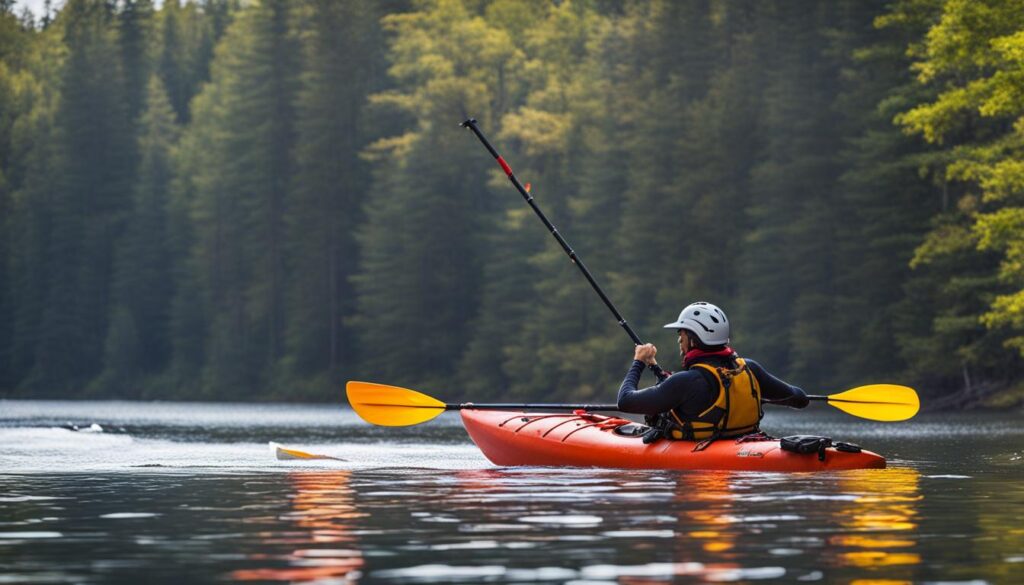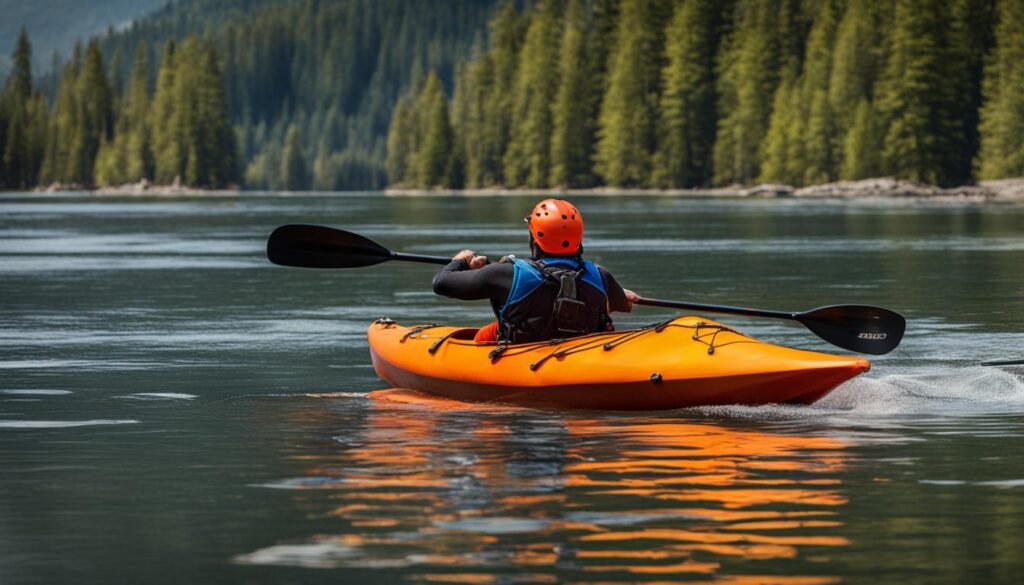If you’re a solo kayaker, it’s important to be prepared for any emergency that may arise while you’re out on the water. Knowing self-rescue methods can mean the difference between a minor mishap and a dangerous situation. In this article, we’ll explore the essential techniques and safety considerations that every solo kayaker should be aware of.
Key Takeaways:
- Mastering self-rescue techniques is crucial for solo kayakers.
- Straddle re-entry, self-rescue with a paddle float, and re-entry and roll are effective self-rescue methods.
- Having the right gear, such as buoyancy bags or bulkheads, is essential for successful self-rescue.
- Planning for emergencies, notifying someone of your trip plans, and carrying emergency communication devices are vital safety considerations.
- Always prioritize personal safety and make smart decisions based on weather conditions and water environments.
Straddle Re-entry: Getting back into the kayak quickly and efficiently
Straddle re-entry is a self-rescue technique that can be used to quickly get back into the kayak after a capsize. This method is suitable for both sit-on-top kayaks and sea kayaks with large cockpits. By turning the kayak right side up and straddling it, you can easily maneuver yourself back into the seat area.
It’s important to practice this technique and have the necessary gear to ensure a successful self-rescue. One essential piece of equipment is buoyancy bags or bulkheads, which provide extra flotation to the kayak and make it easier to re-enter. These bags or bulkheads help keep the kayak stable and prevent it from sinking or filling with water during the re-entry process.
To perform a straddle re-entry, follow these steps:
- Hold onto the kayak’s grab loop or any other secure point to steady yourself.
- Flip the kayak back over, ensuring it is right side up.
- Straddle the kayak, facing the front or back.
- Use your hands to crawl forward or backward, depending on your orientation, until you reach the seat area.
- Once you’re in the seat area, rotate your body and slide your legs inside the kayak.
- Gradually lower yourself into the seat while maintaining your balance and stability.
Remember to practice this technique in calm waters before attempting it in more challenging conditions. Proper technique and familiarity with your kayak will make the straddle re-entry process quicker and more efficient, allowing you to get back on the water with confidence.

| Pros | Cons |
|---|---|
| Simple and easy to learn | May be challenging in rough or choppy waters |
| Works well for both sit-on-top and sea kayaks | Requires practice to maintain balance and stability |
| No additional equipment necessary | May struggle to re-enter the kayak if wearing restrictive clothing |
| Can be performed without a paddle | Requires upper body strength and flexibility |
Self-Rescue with a Paddle Float: Adding Stability and Support
When it comes to preparing for solo kayak emergencies and self-rescue in remote kayaking, many experienced solo kayakers rely on a invaluable piece of gear: the paddle float. A paddle float is a device that can be attached to one end of the paddle to provide extra stability and support during the self-rescue process.
Using a paddle float is simple yet effective. Once you’ve capsized, inflate the paddle float and attach it securely to the paddle. Then, position the paddle across the kayak, creating a stable outrigger. By leveraging the added buoyancy and stability provided by the paddle float, you can easily re-enter the kayak and get back in the seat area.
It’s important to practice this self-rescue technique before embarking on solo kayak trips and ensure that the paddle float is securely attached to the paddle. By mastering this method, you’ll have an additional tool in your self-rescue arsenal, giving you more confidence and peace of mind during your solo kayaking adventures.

Benefits of Self-Rescue with a Paddle Float
- Increased Stability: The paddle float provides added buoyancy and stability, making it easier to re-enter the kayak.
- Independence: With the paddle float, you don’t need to rely on external assistance for self-rescue, allowing you to maintain your independence while kayaking solo.
- Remote Kayaking Safety: When kayaking in remote areas where help may not be readily available, being able to self-rescue using a paddle float can be crucial for your safety.
Solo Kayaking Safety Drills: Mastering the Re-entry and Roll Technique
For experienced kayakers, the re-entry and roll technique is an advanced self-rescue method that can be a valuable tool in challenging conditions. This technique combines bracing and rolling movements to regain control and re-enter the capsized kayak. It requires practice, experience, and a reliable roll to execute successfully.
The re-entry and roll technique is particularly useful in rough sea conditions where other self-rescue methods may be less effective. It allows kayakers to quickly slide their legs back into the kayak and roll themselves upright again, maintaining stability and control. However, it’s important to note that this technique is advanced and should only be attempted by those with sufficient experience and skills.
“The re-entry and roll technique is a game-changer for solo kayakers facing challenging conditions. It gives you the confidence and ability to quickly recover from a capsize and continue your journey with minimal interruption.” – Experienced solo kayaker
Practicing the re-entry and roll technique in calm waters is essential before attempting it in more challenging conditions. By refining your bracing and rolling skills, you’ll build the muscle memory necessary for a successful self-rescue. It’s also crucial to be aware of your own limitations and exercise caution when deciding whether it’s appropriate to attempt the re-entry and roll technique.
Remember, solo kayaking safety techniques are all about preparedness and skill development. While the re-entry and roll technique is an excellent tool to have in your self-rescue repertoire, it’s equally important to prioritize safety, plan for emergencies, and carry the appropriate gear. By mastering this advanced technique and implementing good safety practices, you can enjoy your solo kayaking adventures with confidence and peace of mind.
Table: Comparison of Self-Rescue Techniques for Solo Kayakers
| Self-Rescue Technique | Suitability | Stability | Difficulty |
|---|---|---|---|
| Straddle re-entry | Both sit-on-top and sea kayaks with large cockpits | Good stability with proper gear | Beginner-friendly |
| Self-rescue with a paddle float | All types of kayaks | Added stability with paddle float | Moderate difficulty, requires practice |
| Re-entry and roll | Experienced kayakers | Excellent stability if executed correctly | Advanced, requires skill and experience |
Important Safety Considerations for Solo Kayaking
When embarking on a solo kayaking adventure, your safety should always be a top priority. Proper planning and communication can make all the difference in ensuring a smooth and secure trip. Here are some essential safety considerations to keep in mind when kayaking alone:
- Plan your trip: Before heading out, make sure to thoroughly plan your route and research the water conditions. Familiarize yourself with the area, including any potential hazards or currents. Let someone reliable know your itinerary and expected return time.
- Carry emergency communication devices: Having a reliable means of communication is crucial in case of unforeseen emergencies. Consider carrying a waterproof VHF radio or a personal locator beacon (PLB) to call for help if needed.
- Be prepared with self-rescue gear: Ensure you have the necessary self-rescue gear, such as a paddle float, bilge pump, and rescue knife. These tools can assist you in getting back into your kayak or dealing with other emergency situations.
- Know your limitations: Solo kayaking requires a certain level of skill and experience. Be honest with yourself about your abilities and only venture into conditions that you are comfortable handling. If unsure, consider taking a kayaking course or joining a guided trip.
Remember, accidents can happen even to experienced kayakers, so it’s essential to prioritize your safety. By taking precautions, planning ahead, and being well-equipped, you can enjoy the serenity of solo kayaking with peace of mind.
Emergency Communication Devices Comparison
| Device | Pros | Cons |
|---|---|---|
| VHF Radio | Allows for two-way communication with other boaters and emergency services. Can access weather updates and distress channels. | Requires a clear line of sight for communication. May have limited range in remote areas. |
| Personal Locator Beacon (PLB) | Transmits a distress signal to emergency services, providing your precise GPS location. Does not rely on line-of-sight communication. | Signal can take time to reach emergency services, depending on the location. Requires registration and periodic battery replacement. |
Choose a communication device that suits your kayaking needs and provides the necessary coverage for your planned trips. Always familiarize yourself with the operation and limitations of the device chosen.
Remember, solo kayaking can be a rewarding and exhilarating experience, but it’s crucial to prioritize safety at all times. By taking the necessary precautions and staying prepared, you can enjoy your solo adventures with confidence.
Conclusion
Solo kayakers can enjoy their adventures on the water with confidence by mastering self-rescue techniques. By practicing straddle re-entry, self-rescue with a paddle float, and re-entry and roll, you can stay safe and minimize the risks associated with solo kayaking.
Remember to prioritize safety and be prepared for emergencies. Always have the necessary gear, such as buoyancy bags or bulkheads, and the skills to perform a self-rescue if needed. It’s important to plan for potential emergencies, notify someone of your trip plans, and carry emergency communication devices.
Whether you’re a beginner or an experienced kayaker, solo kayaking can be a thrilling and rewarding experience. Just make sure to prioritize personal safety, be aware of your limitations, and make smart decisions when it comes to weather conditions and water environments. With the right preparations and skills, you can have a safe and enjoyable solo kayaking trip. Stay safe and have fun out on the water!
FAQ
What are the self-rescue methods for solo kayakers?
The self-rescue methods for solo kayakers include straddle re-entry, self-rescue with a paddle float, and re-entry and roll.
How does straddle re-entry work?
Straddle re-entry involves turning the kayak right side up and straddling it to maneuver back into the seat area.
How does self-rescue with a paddle float work?
Self-rescue with a paddle float involves attaching the float to one end of the paddle to provide stability and support during re-entry into the kayak.
What is the re-entry and roll technique?
The re-entry and roll technique is an advanced self-rescue method that involves using bracing and rolling movements to slide legs back into the capsized kayak and roll back up again.
What safety considerations are important for solo kayaking?
Important safety considerations for solo kayaking include planning for emergencies, carrying emergency communication devices, and being aware of weather conditions and water environments.
How can solo kayakers stay safe and minimize risks?
Solo kayakers can stay safe and minimize risks by practicing self-rescue techniques, prioritizing personal safety, and having the necessary gear and skills to perform a self-rescue if needed.





